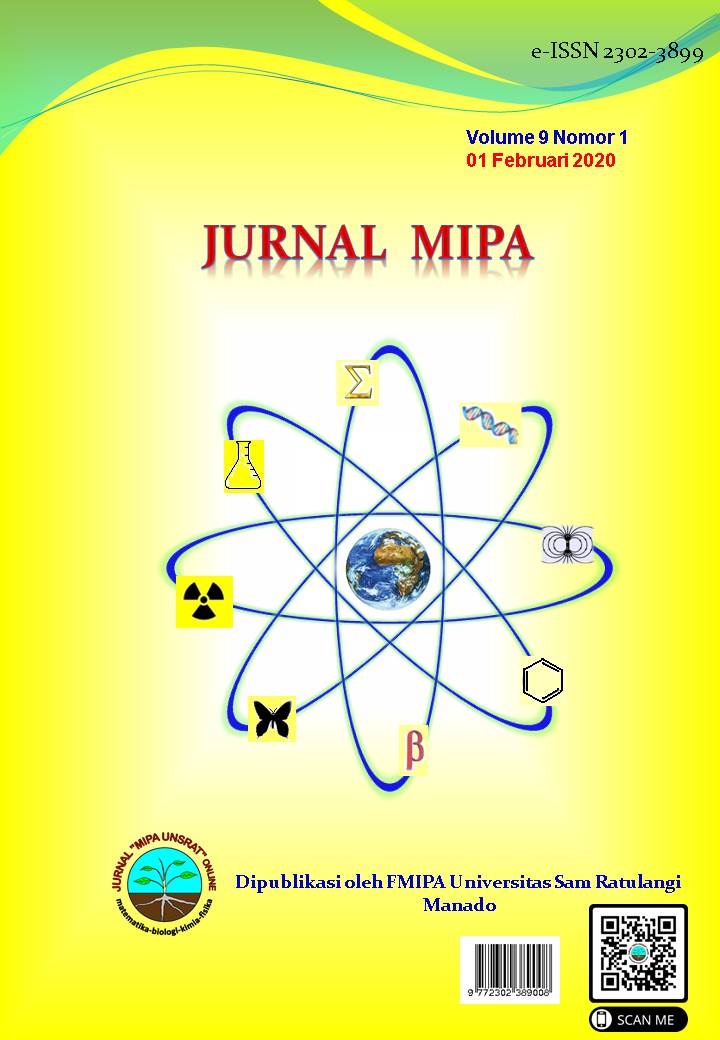Pembuatan dan Karakterisasi Bioplastik Berbahan Dasar Biomassa dengan Plasticizer Gliserol
DOI:
https://doi.org/10.35799/jmuo.9.1.2020.27420Keywords:
Bioplastics, Cassava Starch, Glycerol, AlcoholAbstract
Penelitian ini bertujuan untuk membuat dan mengkarakterisasi bioplastik yang memanfaatkan biomassa singkong. Pembuatan bioplastik dilakukan dengan dua variasi campuran yaitu pati singkong sebagai bahan dasar, gliserol + air sebagai plasticizer, asam asetat (cuka) sebagai katalis dan variasi kedua dengan kombinasi yang sama dengan penambahan alkohol sebagai pembanding. Karakterisasi bioplastik meliputi pengamatan permukaan menggunakan SEM; kristalinitas menggunakan XRD; penentuan gugus fungsi menggunakan FTIR; serta menganalisis sifat termal menggunakan TGA dan DSC. Hasil karakterisasi menunjukkan bahwa bioplastik dengan kombinasi pati singkong+ gliserol + air + asam asetat (cuka) + alkohol mempunyai tingkat degradasi yang tinggi. Hal ini sesuai dengan analisis XRD dimana kombinasi ini memiliki nilai kristalinitas rendah. Hasil spektra IR menunjukkan adanya gugus C-H Alkana, C=O ester, dan C-H Alkena. Sementara hasil SEM memperlihatkan permukaan yang rata dan hasil analisis TGA/DSC yang memperlihatkan pengurangan massa sebesar 2,3234 mg
This study aims to create and characterize bioplastics that utilize cassava biomass. The making of bioplastics is carried out for two variations of mixture, namely cassava starch as the material-based, glycerol + water as plasticizer, acetic acid (vinegar) as a catalyst and the second variation with the same combination with the addition of alcohol as a comparison. Characterization of bioplastics includes surface observations using SEM; crystallinity using XRD; determination of functional groups using FTIR; and analyzing of thermal properties using TGA and DSC. The characterization results show that bioplastics with a combination of cassava starch + glycerol + water + acetic acid (vinegar) + alcohol have a high degree of degradation. This is in accordance with the XRD analysis where this combination has a low crystallinity value. IR spectra showed that the presence of C-H Alkana groups, C = O esters, and C-H alkenes. While the SEM results showed a flat surface and the results of the TGA / DSC analysis which showed a mass reduction of 2.3234 mg.
This study aims to create and characterize bioplastics that utilize cassava biomass. The making of bioplastics is carried out for two variations of mixture, namely cassava starch as the material-based, glycerol + water as plasticizer, acetic acid (vinegar) as a catalyst and the second variation with the same combination with the addition of alcohol as a comparison. Characterization of bioplastics includes surface observations using SEM; crystallinity using XRD; determination of functional groups using FTIR; and analyzing of thermal properties using TGA and DSC. The characterization results show that bioplastics with a combination of cassava starch + glycerol + water + acetic acid (vinegar) + alcohol have a high degree of degradation. This is in accordance with the XRD analysis where this combination has a low crystallinity value. IR spectra showed that the presence of C-H Alkana groups, C = O esters, and C-H alkenes. While the SEM results showed a flat surface and the results of the TGA / DSC analysis which showed a mass reduction of 2.3234 mg.






